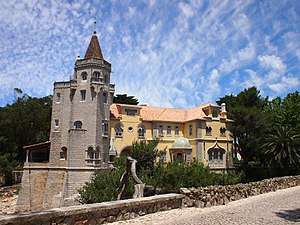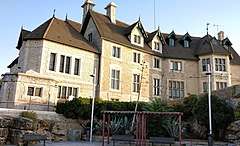Summer architecture
Summer architecture (Portuguese: arquitetura de veraneio) was a Portuguese architectural movement originating in the Portuguese Riviera, in late 19th and early 20th century, when the region became a popular resort destination for the Portuguese Royal Family and the Portuguese aristocracy. The movement is not characterized by any single architectural style or artistic school, but rather unified by common themes, including leisure, wellness, exoticism, and heterotopia.[1]
_(cropped).jpg)
_(cropped).jpg)
The Portuguese Riviera, the coastal region west of the capital Lisbon centered on the cities of Cascais, Sintra, and Oeiras, became a resort destination in the 1870s when King Luís I of Portugal began spending his summers at the Palácio da Cidadela in Cascais. A development boom ensued along the coast, accompanied by the construction of the Cascais railway and the Sintra railway, resulting in the construction of palaces, estates, and chalets of Lisbon's aristocracy for use in the summer.[2][3][4][5][6] The movement's proliferation in the Portuguese Riviera influenced architectural and stylistic tastes across Portugal's other coastal regions, namely Figueira da Foz and Foz do Douro.[7]
History

.jpg)
Sea bathing was already becoming popular in Portugal in the mid-1850s. Cascais, with its protected beaches, was attracting tourists from the capital, Lisbon, and the numbers increased considerably following the opening of a road to the capital in 1863 and the commencement of a stagecoach service. Further stimulus for people to visit Cascais came as a result of the first visit to the town by Queen Maria Pia in September 1867 and the completion of a road from Sintra to Cascais in 1868. Sintra, situated in hills and therefore cooler in the summer, was a popular summer retreat for the Royal Family and the nobility of Lisbon.[8]
Following renovation of the house of the Governor of the Cascais Citadel, the Royal Family stayed there for several weeks in 1870 and did so in subsequent years. It rapidly became normal for the nobility to leave Sintra and transfer to Cascais in early to mid-September in order to be close to the King. However, the quality of hotels in the town was considered poor and noble families began to construct their own homes, beginning with the Duke of Palmela and the Duke of Loulé.
In time, rich businessmen also built summer houses, including Jorge O'Neil, a tobacco baron, and Henrique de Sommer, who became Portugal's leading cement producer.[8][9][10]
Estoril would later become a royal retreat for members of the Spanish Royal Family, Italian Royal Family, French Royal Family, Austrian Imperial Family, and numerous other royal and noble families from across Europe between the World Wars.
Styles

_(cropped).jpg)
In design the new houses were rather different from the houses owned by the nobility in Lisbon, and came to be referred to as summer architecture. They were eclectic, both in their individual designs and in the wide range of architectural styles chosen by the owners, and aimed for a high level of external decoration.[11] Architects used included Thomas Henry Wyatt from England and the Portuguese Raul Lino, who designed around 700 projects in his lifetime and developed the idealized concept of A Casa Portuguesa or the Portuguese House. Styles used included Italianate, Swiss chalet style, English Gothic, Louis XIII style, and neoclassical.[12]
The Palácio do Conde de Castro Guimarães used a Revivalist approach that included Neo-romanticism, Neo-Gothic, Neo-Manueline and Neo-Moorish styles.[13]
Following the overthrow of the monarchy in 1910, there was not the same imperative for affluent citizens of Lisbon to be in Cascais every September. Nevertheless, the building of exotic summer houses continued and extended to neighbouring Estoril, which was becoming a popular resort area and opened a casino in 1916.[9]
Notable examples
- Cascais
- Palácio dos Condes de Castro Guimarães
- Casa Sommer
- Palmela Palace
- Casa de Santa Maria
- Chalet Faial
- Chalet Leitão
- Palácio do Duque de Loulé
- Chalet Ficalho
- Casa dos Pórticos
- Casa d'Orey
- Casa Perestrelo de Vasconcelos
- Casa D. Pedro
- Palacete Seixas
- Casa Maria Helena
- Casa Trindade Baptista
- Palácio dos Condes de Monte Real
- Estoril
- Casa Verdades de Faria
- Chalet Barros
- Cavalariças de Santos Jorge
- Sintra
- Casa dos Penedos
- Palácio Valença
References
- Tiago Freitas, Summer Houses, Testing New Possibilities of Modern Living., retrieved 2020-03-08
- "Área de Reabilitação de Colares – Almoçageme". Câmara Municipal de Sintra (in Portuguese). Retrieved 2020-03-08.
- Ana Teresa Garcia Silva Morgado (2013). A Arquitectura de Veraneio e a sua imagética: Da Boca do Inferno aos Banhos da Poça. 1870 – 1920 [The Summer Architecture and its Image. From Boca do Inferno to Banhos da Poça. 1870 – 1920] (PDF) (Thesis) (in Portuguese). Lisbon: Universidade Lusófona de Humanidades e Tecnologias. p. 12.
Mais tarde, em 1868, por iniciativa de outro benfeitor de Cascais, o então deputado pelo círculo de Sintra Francisco Joaquim da Costa e Silva (1826-?), procedeu-se às obras de melhoramento da estrada que liga Cascais a Sintra, vila esta na altura muito frequentada pela Família Real e outras famílias aristocráticas que aí começavam a edificar palacetes, onde passavam os meses mais quentes do estio, iniciando a moda de veraneio. [...] A Rainha D. Amélia prolonga a sua estadia vilegiaturista em Sintra, o infante D. Manuel prefere Mafra. Apenas D. Carlos e seu irmão, o infante D. Afonso, se mantêm fiéis a Cascais.
- Antunes, Alexandra (2010). "Arquitectura de veraneio no concelho de Oeiras: chalets de Dafundo e Cruz Quebrada, 1898-1900" [Summer architecture in the municipality of Oeiras: chalets of Dafundo and Cruz Quebrada, 1898-1900]. Encontros de História e Património. Diálogos em Noites de Verão 2006-2007 [Meetings of History and Heritage. Dialogues on Summer Nights 2006-2007] (in Portuguese). Espaço e Memória – Associação Cultural de Oeiras / Junta de Freguesia de Oeiras e S. Julião da Barra. pp. 73–87.
- Fernandes, Paulo Almeida. Identidades. Património Arquitectónico do Concelho de Mafra.
Sem o impacto monumental de Cascais ou do Estoril, a Ericeira foi um importante local de veraneio na transição para o séc. XX.
- Silva, Samantha Katrina Ventura da (2018). O Plano de Urbanização da Amadora de Faria da Costa: o projecto e a sua implementação (PDF). Universidade Lusíada.
Nos anos quarenta, à semelhança de outros territórios periféricos a Lisboa, a Amadora antes de o ser era constituída por uma paisagem meramente campesina, pontuada por núcleos residenciais de veraneio da alta burguesia.
- Mexia Lobo, Susana (2012). Arquitectura e Turismo: Planos e projectos. As cenografias do lazer na costa portuguesa, da 1.ª República à Democracia (PDF). Universidade de Coimbra. pp. 192–297.
- Henriques, Joao Miguel (2016). Cascais: 650 Years. Cascais: Cascais Municipality. pp. 53–61. ISBN 9789726372752.
- Maria da Graça Gonzalez Briz (1989). A arquitectura de veraneio os Estoris 1880-1930 (Master's Dissertation) (in Portuguese). hdl:10362/21630 – via Repositório Universidade Nova.
- Maria Isabel Andrade Baptista (May 2012). Casas com história e memória em Cascais: um itinerário turístico pedestre (Report) (in Portuguese). Escola Superior de Hotelaria e Turismo do Estoril. hdl:10400.26/4920 – via Repositório Comum.
- "Summer architecture route" (PDF). Cascais Municipality. Retrieved 24 September 2018.
- Ramalho, Maria. "Casa dos Almadas". Patrimonio Cultural. Retrieved 24 September 2018.
- "Palácio do Conde de Castro Guimarães / Torre de São Sebastião". Sistema de Informação para o Património Arquitetónico. Retrieved 20 January 2018.
_(cropped).jpg)
